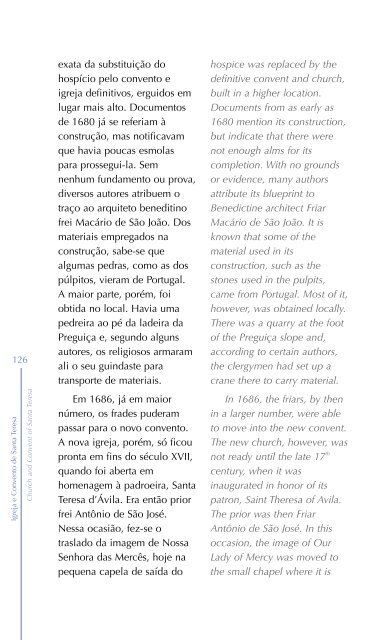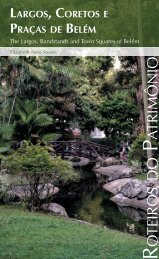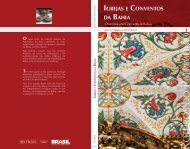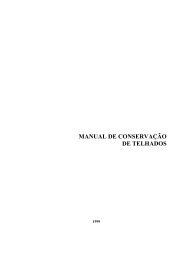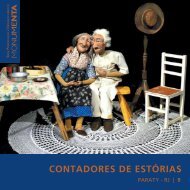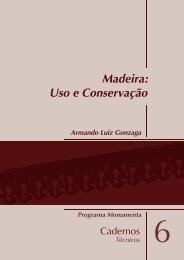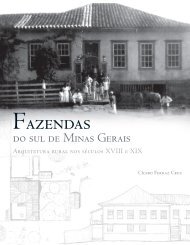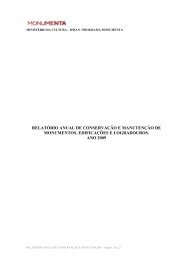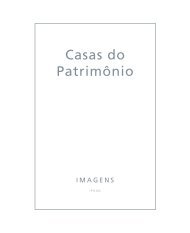Igrejas e Conventos da Bahia - Monumenta
Igrejas e Conventos da Bahia - Monumenta
Igrejas e Conventos da Bahia - Monumenta
Create successful ePaper yourself
Turn your PDF publications into a flip-book with our unique Google optimized e-Paper software.
126<br />
Igreja e Convento de Santa Teresa<br />
Church and Convent of Santa Teresa<br />
exata <strong>da</strong> substituição do<br />
hospício pelo convento e<br />
igreja definitivos, erguidos em<br />
lugar mais alto. Documentos<br />
de 1680 já se referiam à<br />
construção, mas notificavam<br />
que havia poucas esmolas<br />
para prossegui-la. Sem<br />
nenhum fun<strong>da</strong>mento ou prova,<br />
diversos autores atribuem o<br />
traço ao arquiteto beneditino<br />
frei Macário de São João. Dos<br />
materiais empregados na<br />
construção, sabe-se que<br />
algumas pedras, como as dos<br />
púlpitos, vieram de Portugal.<br />
A maior parte, porém, foi<br />
obti<strong>da</strong> no local. Havia uma<br />
pedreira ao pé <strong>da</strong> ladeira <strong>da</strong><br />
Preguiça e, segundo alguns<br />
autores, os religiosos armaram<br />
ali o seu guin<strong>da</strong>ste para<br />
transporte de materiais.<br />
Em 1686, já em maior<br />
número, os frades puderam<br />
passar para o novo convento.<br />
A nova igreja, porém, só ficou<br />
pronta em fins do século XVII,<br />
quando foi aberta em<br />
homenagem à padroeira, Santa<br />
Teresa d’Ávila. Era então prior<br />
frei Antônio de São José.<br />
Nessa ocasião, fez-se o<br />
traslado <strong>da</strong> imagem de Nossa<br />
Senhora <strong>da</strong>s Mercês, hoje na<br />
pequena capela de saí<strong>da</strong> do<br />
hospice was replaced by the<br />
definitive convent and church,<br />
built in a higher location.<br />
Documents from as early as<br />
1680 mention its construction,<br />
but indicate that there were<br />
not enough alms for its<br />
completion. With no grounds<br />
or evidence, many authors<br />
attribute its blueprint to<br />
Benedictine architect Friar<br />
Macário de São João. It is<br />
known that some of the<br />
material used in its<br />
construction, such as the<br />
stones used in the pulpits,<br />
came from Portugal. Most of it,<br />
however, was obtained locally.<br />
There was a quarry at the foot<br />
of the Preguiça slope and,<br />
according to certain authors,<br />
the clergymen had set up a<br />
crane there to carry material.<br />
In 1686, the friars, by then<br />
in a larger number, were able<br />
to move into the new convent.<br />
The new church, however, was<br />
not ready until the late 17 th<br />
century, when it was<br />
inaugurated in honor of its<br />
patron, Saint Theresa of Avila.<br />
The prior was then Friar<br />
Antônio de São José. In this<br />
occasion, the image of Our<br />
Lady of Mercy was moved to<br />
the small chapel where it is


